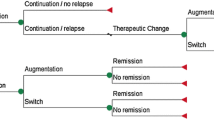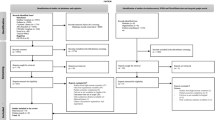Abstract
Depression is a very costly chronic disease. An important cost driver is treatment failure caused by patient noncompliance due, in part, to the adverse effects of medications. Additionally, inadequate duration of therapy and inappropriate medication switching contribute to the high cost of treatment. With the epidemiological data for depression demonstrating a rise in both incidence and prevalence over the last 20 years, and the fact that many of the newer antidepressants will see patent expiry in the near future, previous antidepressant cost-effectiveness scenarios are likely to change. As economic models play an increasingly important role in therapeutic decision-making, clinicians are encouraged to understand the strategies and methods involved in modelling antidepressant therapy.
The aim of this review of the literature and synthesis of the various techniques important to the modelling of antidepressant therapies is for the practitioner to gain an increased understanding of the modelling methods previously utilised and be in a position to better evaluate future health economic models for the treatment of depression.








Similar content being viewed by others
Notes
Someoftheexamineditems(e.g.basecasereference) were explained in Hatziandreu et al.,[8] and are evaluated in section 1.6.The author did state that the decision model in this article was based on the previous model,and cited this reference.
References
Greenberg PE, Stiglin LE, Finkelstein SN. The economic burden of depression in 1990. J Clin Psychiatry 1993; 54: 405–18
Stoudemire A, Frank R, Hedemark N, et al. The economic burden of depression. Gen Hosp Psychiatry 1986; 8: 387–94
Rice DP, Miller LS. The economic burden of affective disorders. Br J Psychiatry 1995; 166: 34–42
West R. Depression. London: Office of Health Economics, 1992
Canadian Coordinating Office for Health Technology Assessment. Selective serotonin reuptake inhibitors (SSRIs) for major depression. Part 1. Evaluation of the clinical literature. Ottawa: Canadian Coordinating Office for Health Technology Assessment, 1997
Canadian Coordinating Office for Health Technology Assessment. Selective serotonin reuptake inhibitors (SSRIs) for major depression. Part 2. The cost-effectiveness of SSRIs in the treatment of depression. Ottawa: Canadian Coordinating Office for Health Technology Assessment, 1997
Nuijten MJ, Hardens M, Souetre E. A Markov process analysis comparing the cost efficacy of maintenance therapy with citalopram versus standard therapy in major depression. Pharmacoeconomics 1995; 8: 159–68
Hatziandreu EJ, Brown RE, Revicki DA, et al. Cost utility of maintenance treatment of recurrent depression with sertraline versus episodic treatment with dothiepin. Pharmacoeconomics 1994; 5: 249–64
Revicki DA, Brown RE, Keller MB, et al. Cost-effectiveness of newer antidepressants compared with tricyclic antidepressants in managed care settings. J Clin Psychiatry 1997; 58: 47–58
Bentkover JD, Feighner JP. Cost analysis of paroxetine versus imipramine in major depression. Pharmacoeconomics 1995; 8: 223–32
Dunbar GC, Cohn JB, Fabre LF, et al. A comparison of paroxetine, imipramine and placebo in depressed outpatients. Br J Psychiatry 1991; 159: 394–8
Simon GE, Von Korff M, Heiligenstein JH, et al. Initial antidepressant choice in primary care: effectiveness and cost of fluoxetine vs tricyclic antidepressants. JAMA 1996; 275: 1897–902
Canadian Coordinating Office for Health Technology Assessment. Guidelines for economic evaluation of pharmaceuticals: Canada. 2nd ed. Ottawa: Canadian Coordinating Office for Health Technology Assessment, 1997
Commonwealth Department of Human Services and Health. Guidelines for the pharmaceutical industry on preparation of submissions to the pharmaceutical benefits advisory committee. Canberra: Commonwealth Department of Human Services and Health, 1995
Anton SF, Revicki DA. The use of decision analysis in the pharmacoeconomic evaluation of an antidepressant: a cost-effectiveness study of nefazodone. Psychopharmacol Bull 1995; 31: 249–58
Hylan TR, Kotsanos JG, Anderson JS, et al. Comparison of a decision analytical model with results from a naturalistic economic clinical trial: an application to evaluating alternative antidepressants. Am J Manag Care 1996; 2: 1211–23
Einarson TR, Arikian SR, Sweeny S, et al. A model to evaluate the cost-efficacy of oral therapies in the management of patients with major depressive disorders. Clin Ther 1995; 17: 136–53
Einarson TR, Addis A, Iskedjian M. Pharmacoeconomic analysis of venlafaxine in the treatment of major depressive disorder. Pharmacoeconomics 1997; 12: 286–96
Kind P, Sorensen J. Modeling the cost-efficacy of the prophylactic use of SSRIs in the treatment of depression. Int Clin Psychopharmacol 1995; 10: 41–8
Revicki DA, Brown RE, Palmer W, et al. Modeling the cost efficacy of antidepressant treatment in primary care. Pharmacoeconomics 1995; 8: 524–40
Drug Topics Red Book. Montvale (NJ): Medical Economics Company, 1998
Frank E, Kupfer DJ, Wagner EF, et al. Efficacy of interpersonal psychotherapy as a maintenance treatment of recurrent depression: contributing factors. Arch Gen Psychiatry 1991; 48: 1053–9
Klerman GL, Weissman MM. The course, morbidity and costs of depression. Arch Gen Psychiatry 1992; 49: 831–4
Prien RF, Kupfer DJ. Continuation drug therapy for major depressive episodes: how long should it be maintained? Am J Psychiatry 1986; 143: 18–23
Agency for Health Care Policy and Research (AHCPR). Clinical practice guidelines for depression (‘depression in primary care’ guidelines), 1998. Available from: http://www.ahcpr.gov/clinic/medtep/resource.htm [Accessed 2000 Apr 13]
Montgomery SA, Henry J, McDonald G, et al. Selective serotonin reuptake inhibitors: meta-analysis of discontinuation rates. Int Clin Psychopharmacol 1994; 9: 47–53
Doubilet P, Begg CB, Weinstein MC, et al. Probabilistic sensitivity analysis using Monte Carlo simulation: a practical approach. Med Decis Making 1985; 5: 157–77
Medical Information Management Service (MIMS) [1994 data]. London: MediMedia International, 1994
Revicki DA, Wood M. Patient-assigned health state utilities for depression-related outcomes: differences by depression severity and antidepressant medication. J Affect Disord 1998; 48: 25–36
Stoner SC, Marken PA, Watson WA, et al. Antidepressant overdoses and resultant emergency department services: the impact of SSRIs. Psychopharmacol Bull 1997; 33: 667–70
Kupfer DJ. Long-term treatment of depression. J Clin Psychiatry 1991; 52: 28–34
Copley-Merriman C, Lair TJ. Valuation of medical resource units collected in health economic studies. Clin Ther 1994; 16: 553–68
SMLTREE generic software package, version 2.9. Roslyn (NY): Jim Hollenberg, 1989
Physicians desk reference (PDR). Montvale (NY): Medical Economics Company, 1997
Celexa™ (citalopram HBr) [package insert]. St Louis (MO): Forrest Laboratories, Inc., 1998
Department of Health and Human Services. Approved drug products with therapeutic equivalence evaluations. 17th ed. Washington (DC): Department of Health and Human Services, Public Health Service, FDA, Division of Database Management, 1997
Incidence and prevalence database (IPD), 1988. Available from: http://open.academic.N2K.com/p/P0465AA.htm [Accessed 2000 Apr 13]
Kessler RC, McGonagle KA, Nelson CB, et al. Sex and depression in the National Comorbidity Survey II: cohort effects. J Affect Disord 1994; 30: 15–26
Doogan DP, Caillard V. Sertraline in the prevention of depression. Br J Psychiatry 1992; 160: 217–22
Mueller TI, Leon AC. Recovery, chronicity, and levels of psychopathology in major depression. Psychiatr Clin North Am 1996; 19: 85–102
Keller MB, Shapiro RW, Lavori PW, et al. Relapse in major depressive disorder: analysis with the life table. Arch Gen Psychiatry 1982; 39: 911–5
Song F, Freemantle N, Sheldon TA, et al. Selective serotonin reuptake inhibitors: meta-analysis of efficacy and acceptability. BMJ 1993; 306: 683–7
Anderson IM, Tomenson BM. Treatment discontinuation with selective serotonin reuptake inhibitors compared with tricyclic antidepressants: a meta-analysis. BMJ 1995; 310: 1433–8
Medispan™ database.Available from: http://www.medispan.com
Price Probe™ database. Available from: http://www.firstdatabank.com/drug/nddf_product_line/software_products/price_probe/price_probe.htm
First Databank database. Available from: http://www.firstdatabank.com
Buxton MJ, Drummond MF, Van Hout BA, et al. Modeling in economic evaluation: an unavoidable fact of life. Health Econ 1997; 6: 217–27
Acknowledgements
Dr Jones is a psychopharmacy research fellow at the Western Missouri Mental Health Center in Kansas City, Missouri, and was a Pharm.D. student completing a rotation in pharmacoeconomics in the Outcomes Research Division of Parke-Davis Pharmaceuticals, Ann Arbor, Michigan at the time of data compilation. Dr Cockrum is Senior Outcomes Researcher with Alcon Laboratories, Inc., Fort Worth, Texas, and was a pharmacoeconomist in the Outcomes Research Division of Parke-Davis Pharmaceuticals at the time of data compilation.
Author information
Authors and Affiliations
Rights and permissions
About this article
Cite this article
Jones, M.T., Cockrum, P.C. A Critical Review of Published Economic Modelling Studies in Depression. Pharmacoeconomics 17, 555–583 (2000). https://doi.org/10.2165/00019053-200017060-00003
Published:
Issue Date:
DOI: https://doi.org/10.2165/00019053-200017060-00003




